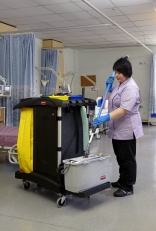Home › magazine › september 2011 › special features › No longer just a mop and bucket
No longer just a mop and bucket
13th of September 2011With growing demands and expectations worldwide on the cleaning industry to continually improve the effectiveness of mopping systems it has become apparent that the traditional mop and bucket system is no longer appropriate. Rubbermaid, writing exclusively for ECJ, looks at how this part of the industry is developing.
With growing demands and expectations on the cleaning industry to continually improve the effectiveness of mopping systems it has become apparent that the traditional mop and bucket system is no longer appropriate. Today the market has expanded dramatically and we find ourselves with an overwhelming array of choices.
The primary considerations of most organisations when planning their investment fall into one of three categories: productivity and efficiency gains; sustainability; and ergonomics. All three categories are successfully served with microfibre mops; their increased use in the last few years is a testament to the fact they are increasingly viewed as the professional’s choice.
Productivity and efficiency
For many businesses productivity and efficiency are primary concerns when it comes to choosing cleaning equipment. They want products that will complete the task to the standard they require, in the quickest time.
Microfibre mops are produced from a combination of microscopic polyester and polyamide fibres which are split during manufacturing to form a dense blend of microscopic hooks less than 1/1000th the width of traditional cloth fibres. Their size allows deep cleaning to be achieved in even the smallest of crevices and on a number of surface types.
The positive charge of the microfibre mop head attracts negatively charged dust and dirt particles and holds onto them. This improves efficiency by ensuring the dirt is removed rather than redistributed. In addition, the high density of the material makes it extremely absorbent; creating a safer environment by reducing the risk of accidents - quickly removing residue from spillages.
The versatility of this method means it is possible to clean using the mop wet or dry. In addition to this a number of different microfibre mop heads can be employed to achieve the desired effect or match to the task requirements. Features such as a foldable mopping system are invaluable when targeting corners or hard-to-reach areas. Different styles of mop can be used depending on the type of flooring or task: a flat mop system is more suitable for hard surfaces whereas zig-zag shaped microfibre is particularly effective on floors with grout lines.
The initial cost of implementing such a cleaning system can be overwhelming with cheaper products providing a clear short term cost benefit. However they cannot offer superior performance or maintain the same level of hygiene standards. High quality, modern mopping solutions may require more investment but the proven reduction in chemical and labour costs dramatically reduce its lifetime cost.
Sustainability
Sustainability is becoming a growing concern for companies and is now a fundamental consideration for cleaning professionals in order to remain competitive and meet legislative pressures. The very fact microfibre mops dramatically reduce chemical usage and water consumption ensures they are increasingly favoured therefore.
Cleaning professionals must find a delicate balance between meeting hygiene standards and protecting their employees and the environment from the chemicals used in the process. The reduction in chemical usage has become a key selling point for many manufacturers; microfibre systems having notable cost reductions in chemical usage for the user over the product lifetime. One study found that using a microfibre mop reduces chemical consumption by 95 per cent compared to traditional mopping. This vast reduction limits employees contact with hazardous chemicals that can be harmful to their health.
In addition, water consumption is also cut by 90 per cent. This ensures clean water is not wasted and prevents employees having to refill their systems as often, proving more time efficient. And because it holds more water without dripping, there is less potential for accidents.
Microfibre products can be washed, allowing them to be re-used up to 1,000 times. This extends their life span ensuring they last 10 times longer than traditional cotton mops - reducing waste. Energy and transportation costs are limited as unlike traditional mops, microfibre can be cleaned using an in-house domestic washing machine.
Ergonomics
The ergonomics of the product have gained in importance as a decision factor when choosing which system to purchase. Companies want to ensure their staff have access to equipment that will not have detrimental effects on their health in the future. Key to this is combining the right system with a lightweight, ergonomic handle. Microfibre mops weigh around 1.3 kg which is a dramatic reduction compared to the six kg of the traditional cotton loop mop.
Specialised handles add to mops' comfort and ease of use with the development of features such as trigger handles helping to ensure labour intensity is reduced. Telescopic or extendable handles allow for mops to be adjusted to a comfortable length when cleaning.
The aesthetics of the products is an additional area of growing importance. With an increased emphasis on daily cleaning, organisations feel the need to portray a professional image, and require their cleaning equipment to reflect this message.
Product developments
In recent years a number of developments have enabled an expansion in the possible applications for mopping systems. Sophisticated solutions are now used in hygiene-critical areas such as hospitals. This is largely due to the development in microfibre technology. Using such systems eliminates the risk of cross-contamination by disposing of the used pads rather than returning them to the cleaning solution. This ensures water is not contaminated and helps with infection control. With traditional systems the same cleaning equipment could be used throughout the hospital, facilitating the spread of disease and infection.
The issue of water contamination has also been tackled a different way with more recent developments including a clean water system that filters dirty water. The combination of such a filter bucket with a microfibre mop has been proven to dramatically increase performance levels - helping to maintain a healthy, safe environment.
Additionally, unlike traditional cotton mops, the static charge of the microfibre prevents dirt from simply being redistributed. The microscopic nature of the fibres allows even the smallest pores to be penetrated and a flat mop system makes it possible to reach corners.
Features such as on-board reservoirs have allowed the expansion of spot cleaning by enabling the user to release the cleaning solution as it is needed. This innovation has proven to be efficient for flash cleaning. In line with this a variety of curved mops now make it possible to clean curved surfaces effectively; expanding possible uses.
Two-sided mops allow a different material to be used on each surface. This means that optimal cleaning performance can be achieved for different environments from a single product. This has become invaluable in fast paced environments.
Ergonomic advances have made modern mopping systems lighter, faster and easier to use. Improved absorption rates allow more water to be held within the mop, reducing the need for cleaning personnel to return to the bucket. In line with this a reduction in water and chemical consumption means fewer trips required to refill buckets.
There have recently been new developments in floor cleaning solutions resulting in the introduction of compact floor cleaning machines to the market. Despite claims of increased economic benefit from the new systems, mopping solutions still hold a firm place in the market.
Floor cleaning machines offer the same benefits in water and chemical reduction however mopping can still be viewed as the more sustainable option - not being a drain on energy sources. The non-motorised systems do not require recharging or access to mains electricity which can be time consuming and inconvenient.
When cleaning busy areas the mopping system is less intrusive as it is smaller and quieter. The compact cleaners lack the same versatility; mops can be adapted to combat a variety of surface types by changing their head. With compact machines there is an issue that each machine is designed for a specific purpose. A smaller machine would be needed for tight areas underneath objects but a larger machine is more appropriate for large open spaces in locations such as train stations. Purchasing can be costly, depleting the apparent economic benefits provided.
One of the major claims made by compact floor cleaning machine manufacturers is that their innovations eliminate the safety risks of mopping. This may be a valid point with regard to traditional systems, however with new microfibre technology we have shown that this risk no longer exists.
The cleaning industry is continually developing new products and technologies to improve cleaning standards worldwide. Expanding product ranges and new innovations can make choosing the appropriate system for a particular specification difficult. Most companies will find a compromise between productivity and cost effectiveness, although it appears quality is of growing concern - introducing additional decision areas.









